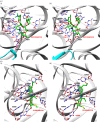Reduced ribosomes of the apicoplast and mitochondrion of Plasmodium spp. and predicted interactions with antibiotics
- PMID: 24850912
- PMCID: PMC4042851
- DOI: 10.1098/rsob.140045
Reduced ribosomes of the apicoplast and mitochondrion of Plasmodium spp. and predicted interactions with antibiotics
Abstract
Apicomplexan protists such as Plasmodium and Toxoplasma contain a mitochondrion and a relic plastid (apicoplast) that are sites of protein translation. Although there is emerging interest in the partitioning and function of translation factors that participate in apicoplast and mitochondrial peptide synthesis, the composition of organellar ribosomes remains to be elucidated. We carried out an analysis of the complement of core ribosomal protein subunits that are encoded by either the parasite organellar or nuclear genomes, accompanied by a survey of ribosome assembly factors for the apicoplast and mitochondrion. A cross-species comparison with other apicomplexan, algal and diatom species revealed compositional differences in apicomplexan organelle ribosomes and identified considerable reduction and divergence with ribosomes of bacteria or characterized organelle ribosomes from other organisms. We assembled structural models of sections of Plasmodium falciparum organellar ribosomes and predicted interactions with translation inhibitory antibiotics. Differences in predicted drug-ribosome interactions with some of the modelled structures suggested specificity of inhibition between the apicoplast and mitochondrion. Our results indicate that Plasmodium and Toxoplasma organellar ribosomes have a unique composition, resulting from the loss of several large and small subunit proteins accompanied by significant sequence and size divergences in parasite orthologues of ribosomal proteins.
Keywords: Apicomplexa; antibiotics; large subunit (LSU) proteins; organelles; ribosomes; small subunit (SSU) proteins.
Figures





Similar articles
-
Recycling factors for ribosome disassembly in the apicoplast and mitochondrion of Plasmodium falciparum.Mol Microbiol. 2013 Jun;88(5):891-905. doi: 10.1111/mmi.12230. Epub 2013 Apr 24. Mol Microbiol. 2013. PMID: 23614815
-
YihA GTPases localize to the apicoplast and mitochondrion of the malaria parasite and interact with LSU of organellar ribosomes.Mol Biochem Parasitol. 2020 Mar;236:111265. doi: 10.1016/j.molbiopara.2020.111265. Epub 2020 Feb 11. Mol Biochem Parasitol. 2020. PMID: 32057832
-
Phylogeny and evolution of apicoplasts and apicomplexan parasites.Parasitol Int. 2015 Jun;64(3):254-9. doi: 10.1016/j.parint.2014.10.005. Epub 2014 Oct 14. Parasitol Int. 2015. PMID: 25451217 Review.
-
Translation in Organelles of Apicomplexan Parasites.Trends Parasitol. 2016 Dec;32(12):939-952. doi: 10.1016/j.pt.2016.07.005. Epub 2016 Aug 12. Trends Parasitol. 2016. PMID: 27527393 Review.
-
Targeting Protein Translation in Organelles of the Apicomplexa.Trends Parasitol. 2016 Dec;32(12):953-965. doi: 10.1016/j.pt.2016.09.011. Epub 2016 Oct 25. Trends Parasitol. 2016. PMID: 27793563 Review.
Cited by
-
Subcellular Compartments Interplay for Carbon and Nitrogen Allocation in Chromera velia and Vitrella brassicaformis.Genome Biol Evol. 2019 Jul 1;11(7):1765-1779. doi: 10.1093/gbe/evz123. Genome Biol Evol. 2019. PMID: 31192348 Free PMC article.
-
Resistance to apicoplast translational inhibitors in Plasmodium.Int J Parasitol Drugs Drug Resist. 2025 Aug;28:100597. doi: 10.1016/j.ijpddr.2025.100597. Epub 2025 May 10. Int J Parasitol Drugs Drug Resist. 2025. PMID: 40381412 Free PMC article. Review.
-
Chloramphenicol acetyltransferase-a new selectable marker in stable nuclear transformation of the red alga Cyanidioschyzon merolae.Protoplasma. 2017 Jan;254(1):587-596. doi: 10.1007/s00709-015-0936-9. Epub 2015 Dec 29. Protoplasma. 2017. PMID: 26715590
-
Transcriptional changes in Plasmodium falciparum upon conditional knock down of mitochondrial ribosomal proteins RSM22 and L23.PLoS One. 2022 Oct 6;17(10):e0274993. doi: 10.1371/journal.pone.0274993. eCollection 2022. PLoS One. 2022. PMID: 36201550 Free PMC article.
-
Insights into the evolution and drug susceptibility of Babesia duncani from the sequence of its mitochondrial and apicoplast genomes.Int J Parasitol. 2019 Feb;49(2):105-113. doi: 10.1016/j.ijpara.2018.05.008. Epub 2018 Aug 31. Int J Parasitol. 2019. PMID: 30176236 Free PMC article.
References
-
- Wilson RJM, Gardner MJ, Feagin JE, Williamson DH. 1991. Have malaria parasites three genomes? Parasitol. Today 7, 134–136. (doi:10.1016/0169-4758(91)90276-T) - DOI - PubMed
-
- Gardner MJ, et al. 2002. Genome sequence of the human malaria parasite Plasmodium falciparum. Nature 419, 498–511. (doi:10.1038/nature01097) - DOI - PMC - PubMed
-
- Wilson RJ, et al. 1996. Complete gene map of the plastid-like DNA of the malaria parasite Plasmodium falciparum. J. Mol. Biol. 261, 155–172. (doi:10.1006/jmbi.1996.0449) - DOI - PubMed
-
- Feagin JE, Gardner MJ, Williamson DH, Wilson RJ. 1991. The putative mitochondrial genome of Plasmodium falciparum. J. Protozool. 38, 243–245. (doi:10.1111/j.1550-7408.1991.tb04436.x) - DOI - PubMed
-
- Feagin JE, Werner E, Gardner MJ, Williamson DH, Wilson RJ. 1992. Homologies between the contiguous and fragmented rRNAs of the two Plasmodium falciparum extrachromosomal DNAs are limited to core sequences. Nucleic Acids Res. 20, 879–887. (doi:10.1093/nar/20.4.879) - DOI - PMC - PubMed
Publication types
MeSH terms
Substances
LinkOut - more resources
Full Text Sources
Other Literature Sources
Medical
Molecular Biology Databases
Miscellaneous

